On this page
- Report Highlights
- Preface
- Background
- Challenges with security, staffing, and workforce equity affect services and worsen morale
- Library leaders have an opportunity to address employee concerns when planning for fully reopening after construction
- Recommendations
- Objectives, Scope, & Methodology
- Staff
- Related documents
A letter from Audit Director Dewees
I want to thank the staff at the Multnomah County Library for sharing their time and expertise during this audit. Our office last audited the Library in 2004. That report primarily focused on Library service delivery amid funding uncertainties at the time. The Library is once again at a critical juncture.
In 2020, the Library passed a bond measure to build a new flagship location in East Multnomah County and make improvements to existing locations, among other investments. This is a significant period of expansion for the Library system. This presents an exciting opportunity for expanding equitable access to Library services. We believe that delivering equitable service to Library patrons will require a healthy work environment. Audit staff found that many library employees are concerned about issues such as safety and staffing. The audit contains several recommendations to address these concerns. Each recommendation has a due date and the Auditor’s Office will return to follow up on the status.
To prevent the perception of a conflict of interest, I oversaw this audit since Auditor McGuirk’s spouse is an on-call employee at the library. Auditor McGuirk did not participate in the planning, research, writing, or any other phase of the audit.
Sincerely,
Nicole Dewees, MBA, CIA
Audit Director
Report Highlights
What We Found
The Multnomah County Library workforce plays a key role in helping the Library achieve its mission to “empower our communities to learn and create.” Library employees serve as an important connection to welcome communities who have historically been excluded from accessing library services.
We found that the Library has struggled to respond to the changing safety and security landscape. Employees are frustrated about the gaps in the response to serious incidents, particularly for employees who frequently interact with the public. Improved coordination is needed between departments and county-wide services to develop a proactive response to serious security incidents.
In recent years, the Library has hired its most diverse workforce to better reflect the diverse communities it serves. However, we heard that some employees do not feel valued and employees with specific language and cultural skills need more clarity about their roles. Employees report lower staffing levels in neighborhood libraries contributes to reduced services, poor morale, and concerns about workplace safety.
Why We Did This Audit
Before the audit, previous employee surveys conducted by our office and Multnomah County’s Evaluation and Research Unit revealed high levels of dissatisfaction within the Library work environment. The Library is in the process of renovating and constructing new buildings, including a new flagship library in East Multnomah County. By addressing workforce concerns, they can be better positioned to provide high quality services to the public when these new or updated locations open.
What We Recommend
Our report includes 10 recommendations. Key recommendations, paraphrased, include:
- Implementing security processes to: ensure compliance with OR OSHA rules; analyze trends for more a proactive response; and improve employee support after incidents
- Planning for staffing after construction is complete, while addressing the workforce equity and security concerns raised in this report
- Improving internal communications to rebuild trust
Preface
Acknowledgement
We appreciate Library employees and leaders giving their time to this audit, especially while there were many changes in Library workplaces. Library employees and leaders have served the public and we recognize their sacrifices and dedicated service through challenging times. The pandemic exposed gaps in our support systems. These gaps placed a burden on places like public libraries.
We acknowledge that there have been traumatic workplace incidents, in addition to other stressors people have experienced. We thank library employees for sharing their experiences throughout the course of this audit.
A note on language
When people think of libraries, they often think of the physical library in their neighborhood. However, there are additional services and work that go into the entire Multnomah County Library system. For example, employees provide services in the community, move books between locations, develop the collection of books and other materials, and much more. In this report, when we talk about the entire system, we call it “the Library” (capitalized). When we refer to operations just in the public library buildings that people visit, we call them “neighborhood libraries” (lowercased). We are including Central Library, a large flagship library in downtown Portland, in the term “neighborhood libraries,” along with the other 18 libraries across the county and temporary library spaces set up during construction.
Additionally, in this report we refer to categories for the racial and ethnic identities of Library employees. We use the categories that are in the county’s data system, as that is the information available to us. However, we recognize that these categories do not reflect all identities.
Finally, there are instances in the report where we describe traumatic or violent incidents. These descriptions are not detailed; however, some contain examples of violent language and could be triggering for some people. If you find that you need resources to support your health and wellbeing, Multnomah County offers resources for employees and community members. To find support, please contact:
- Multnomah County Behavioral Health Call Center 24/7: 503-988-4888
- Crisis Line for Racial Equity Support: 503-575-3764. This line is staffed by BIPOC Counselors available Mon. - Fri., 8:30 a.m. - 5 p.m.
- Trans Lifeline 24/7 (Spanish available): 1-877-565-8860
Multnomah County Auditor’s Office also compiled
This information is for everyone and emphasizes resources for BIPOC and LGBTQ+ communities to support self-care, resiliency, and improved wellness. County employees can contact the Employee Assistance Program to learn about additional resources.
Background
Library has faced many changes in recent years
Library employees experienced changing workplace expectations in their roles throughout the COVID-19 pandemic. Libraries operated under reduced services for over a year. Some Library employees temporarily moved to emergency operations roles. When neighborhood libraries began to reopen in June 2021, the Multnomah County Library was met with an increase in patrons experiencing behavioral health crises. In addition, the passage of a capital bond measure led to construction-related closures, starting in December 2022.
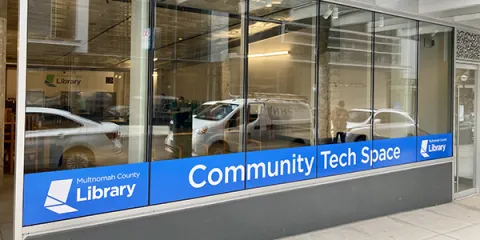
The Library has its own district and stable funding
Library operations are primarily funded by a dedicated property tax for the Library District. Before 2012, the Library relied on temporary levies and the General Fund, the county’s source of unrestricted funding, to finance its operations. In the November 2012 election, Multnomah County voters approved a measure to create a permanent library district. This permanent taxing district provides the Library with a stable source of funding. The District also provides an ongoing source of dedicated funding for library services without having to compete with other programs for General Fund dollars.
The District is governed by the Multnomah County Board of Commissioners, which serves as its five-member Library District Board. Commissioners appoint members of the volunteer Library Advisory Board to advise the Library District on its policies and annual budget.
The Library is currently doing major construction
The downtown Central Library opened in 1913. The Multnomah County Library system has added 18 neighborhood libraries that serve communities across the county. In 2017, the Library published results from a capital planning process conducted by its Community Action Committee. This stakeholder group identified the need to expand library spaces, particularly in East Multnomah County, to ensure equitable access to services.
In the November 2020 General Election, Multnomah County voters passed a $387 million general obligation bond to improve library facilities. The bond project includes renovations of neighborhood libraries, expanded materials handling, a new sorting center, and the construction of the new East County Flagship library.
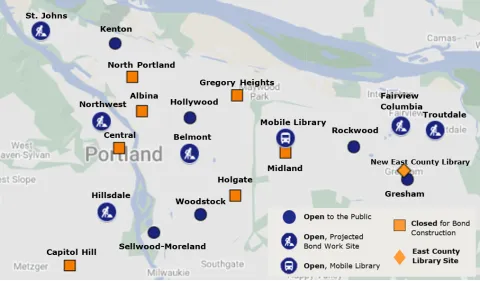
Source: Multnomah County Auditor’s Office, based on information from the Multnomah County Library. Bond-related construction at neighborhood libraries as of October 2023. Shown in orange are the seven neighborhood libraries that are closed for bond-related construction. In blue are locations that are open to the public. Some locations are open and projected to start bond construction. Those locations are shown in blue with the construction icon. Note, the Library has opened temporary service sites during the construction closures that are not included in this map. This includes the Community Tech Space and the University of Oregon NE Portland temporary library site.
The Library has reassigned staff between locations to account for patrons who will visit the neighborhood libraries that will remain open. New services have also been established, like the Community Technology Space in downtown location, while Central Library is closed for most of 2023. The bond-related construction is projected to be completed in 2025. According to the Library, these timelines are estimates and construction could last into 2026.
The pandemic greatly affected Library services
To prevent the spread of COVID-19, county workplaces made significant changes in how they provide services to the public. In the Library system, neighborhood libraries reduced most in-person services for much of 2020 and 2021. Neighborhood libraries began new services, like lending Chromebooks and mailing and delivering books. As programs moved online, the Library also focused on bridging the technology gap through services designed to increase access to internet services and devices.
After COVID-19 pandemic closures, library buildings reopened before bond-related construction closures starting December 2022

Source: Multnomah County Auditor’s Office, based on information from the Multnomah County Library. One or more Library locations are closed indicates that one or more neighborhood library locations were closed for public access to the building. Neighborhood library buildings were closed for in-person services in March 2020 (shown in dark blue). Starting June 1, 2021, library buildings began to reopen to the public over a three-month period (shown in light blue). Library locations were open for in-person services from August 24, 2021 to August 1, 2022 (shown in orange). Starting August 2022, Central Library was closed for construction (shown in light blue) before reopening for one month (orange). In December 2022, library locations began to close for bond-related construction (shown in in dark blue) that are projected to last until 2026. Closures are shown for full months and partial months were rounded.
The pandemic also coincided with the passage of the Library bond in November 2020. After reopening from the pandemic, neighborhood libraries closed for construction closures. Central Library closed for a construction project for a three-month period. Bond-related construction closures started in December 2022. As a result, there have been many changes within the Library work environment.
An announced plan for layoffs in 2020 broke trust
During the COVID-19 pandemic, in the summer of 2020, Library leaders announced plans to lay off employees. They said that it was financially responsible since neighborhood libraries were operating under significantly reduced services. Employees and the union pushed back and plans were scaled back. Library leaders have said that no one was laid off involuntarily. However, some employees took early retirement or voluntary layoff, changed positions, or had their hours reduced. Some employees moved to temporary positions or to other county departments.
Importantly, employee trust in Library leadership was broken. Some employees felt that it was cruel to announce layoffs during a global health crisis, especially since the Library had sufficient resources to continue to pay employees.
Decisions made at that time continue to affect the Library work culture. Some employees we spoke with described an “us versus them” culture. Distrust of executive leadership remains high. We heard from employees who feel that leaders continue to not take their concerns – and consequently their well-being – seriously. This perception has perpetuated the distrust.
The region’s housing and behavioral health crises affect neighborhood libraries
Many community members in Multnomah County face housing and behavioral health crises without access to adequate services. Neighborhood libraries are public spaces that are available and open to all. Patrons in the neighborhood libraries reflect the broader community.
Neighborhood libraries also provide an environment and services that can be beneficial for people with unmet housing or behavioral health needs. For example, neighborhood libraries offer indoor spaces that people can use as a place to rest and be protected from bad weather or air quality issues. They offer access to the internet and charging outlets for electronics. Additionally, they offer valuable information resources.
Anecdotally, neighborhood libraries are serving more patrons with unmet housing and behavioral health needs than they did in the past. Sometimes patrons have unmet needs that neighborhood libraries are not set up to meet, such as a patron in a mental health crisis. These situations can contribute to concerns about security.
Challenges with security, staffing, and workforce equity affect services and worsen morale
Library employees report concerns with security, workforce equity, and staffing. During this audit, we conducted over 60 interviews with Library employees and managers. We also spoke with employees and managers while visiting five neighborhood libraries. To gather additional perspectives, we conducted an anonymous survey sent to all Library employees.
According to Oregon Occupational Safety and Health Administration (OSHA), employers have a responsibility to adopt workplace practices to “provide safe or healthful employment and places of employment.” We acknowledge that there are many factors that can impact workplace safety and security. Our audit focuses on the Library and county’s response to these challenges that are within their ability to directly influence as employers, managers, and organizational leaders.
Defining safety and security
Within Multnomah County, safety and security have been defined in the Workplace Violence Prevention Administrative Procedure 3 (RSK-3) to clarify internal roles and responsibilities.
Safety describes “a condition of being relatively free from hazards that are likely to cause harm or injury”. The county-wide safety lead is the Finance and Risk Management Division, which is within the Department of County Management. Some examples of topics under safety are workplace accidents and injuries.
Security is “a proactive deterrent to manage and mitigate acts of violence, that inflicts direct harm to a person, organization, or property.” The county-wide security lead is the Workplace Security Program, which is within the Director’s Office in the Department of County Management. Some examples of security topics include investigating assaults and other criminal acts in the workplace, managing security vendors, and conducting security assessments of county facilities. The path for resolving security issues may involve working with law enforcement to address potential criminal conduct.
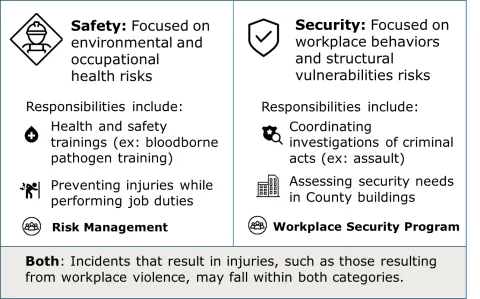
In discussing the Library work environment, we will focus on the response to security-related incidents. These were the types of incidents mentioned most often by Library employees. However, workplace violence incidents that result in injuries, may fall within both safety and security categories. While those distinctions help to clarify internal roles, outside regulators like Oregon OSHA consider addressing safety and security risks under an employer’s responsibility to create a safe workplace.
Security model has changed, more improvements are needed
There have been significant changes in the safety and security landscape of public spaces in Multnomah County. After reopening to the public, the Library experienced several workplace violence incidents. One of these workplace violence incidents occurred on in February 2022 when two Midland Library employees were physically attacked by a patron.
In response to this and other similar incidents, Library employees have called for making changes to the existing safety and security model. One significant change is allowing employees to choose whether to add security-related duties to their position.
Through union negotiations, the person-in-charge (PIC) role and its associated security responsibilities will change to a voluntary “opt-in” model. The person-in-charge (PIC) is a Library employee that serves as the primary responder to security incidents when there are not other security personnel available. They also respond to other customer, staff or facilities issues.
Other significant changes that the library has made include:
- Hiring a safety and security manager
- Condensing Library rules from 27 to 10 rules
- Adding security personnel, including library safety liaison positions and contracted security, to library locations
- Providing security-related training
- Conducting security assessments of neighborhood library buildings, including to make security improvements to neighborhood library buildings during bond-related construction projects
The county has also taken steps to address security risks. Significant county-wide changes include:
- Hiring a workplace security director to create a county-wide security program\Creating a new Workplace Violence (RSK-3) administrative procedure
- Implementing an online reporting portal to report workplace incidents
- Creating a mandatory training on the new incident reporting system for county employees
- Launch of Multnomah County’s 24/7 Security Operations Center
We acknowledge the actions that Library and County have to improve workplace security and respond to workplace violence incidents. In this audit, we will focus on areas that we identified to further strengthen the response. In addition, we will focus on proactive measures, such as analyzing trends in incidents and including employees in the safety and security response.
Staff face serious security risks
Since reopening neighborhood libraries to the public, Library employees report that the nature of security incidents have changed. They described an increase in incidents involving weapons, drug use, and people experiencing behavioral health crises. Longtime employees reported that while these are not new to the Library, the severity and frequency of serious security incidents has increased.
Example of serious incidents include:
- A patron made threatening comments and told staff he had a knife when asked to put on a mask
- Incidents involving public nudity and sexual harassment, some unreported
- A patron made hateful comments about transgender people while carrying a knife
- Employees responding to drug use and overdoses
- A patron evaded security during closing and hid within the library overnight while carrying large knives
The Multnomah County Library has an online incident reporting form to document when patrons violate Library rules and any follow up actions, including a warning or exclusion from Library spaces. Incidents range from minor violations of library rules to serious incidents that involve acts of violence and threats of physical harm. From January 2022 to December 2022, there were more than 2,000 incident reports submitted at Multnomah County Library locations.
Overall, Central Library has the highest number of incidents reports. In 2022, the number of security incidents reported at Central Library (1,109) were four times the number of incidents as Midland Library (247), which saw the next highest number of incidents. Even when accounting for the difference in the number of patrons served by each location, most of the incident reports are from Central Library.
Employees describe the traumatic impact of responding to violent incidents. Repeated exposure to violent incidents is a well-known risk in some professions. Libraries are not usually considered in this category of workplaces. There are national studies, like the 2022 Urban Trauma Library Study, that describe the impact of repeated exposure to trauma on urban library employees.
Central Library was the primary location for incident reports among neighborhood libraries
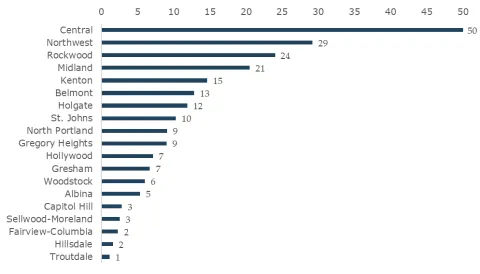
Source: Monthly incident reports shared by the Library from January to December 2022. Average door count data shared by the Library. We analyzed the security incidents per 1,000 visitors to account for differences in the number of patrons served by each neighborhood library. Incidents may range from minor violations of library rules to serious incidents that involve acts of violence and threats of physical harm. Note, the number of incident reports is not the same as the number of security incidents. Some incidents have more than one incident report associated with it when multiple staff members or multiple patrons are involved in a security incident.
Staff who work with the public need more support
Library employees shared that they need support to maintain a welcoming environment for everyone who interacts with the Library system. Employees report that the lack of communication, clear protocols, and inconsistent response following incidents contributed to a poor safety environment.
In the employee survey we conducted, employees who work with the public were less likely to report feeling safe at work. About one in four employees who interact with the public in their role reported feeling safe at work. Responses were similar between employees that interact with the public in-person (27%) and virtually or over the phone (23%). In comparison, about half of library employees who do not interact with the public (55%) report feeling safe at work.
Workers who interact with the public in-person and virtually were less likely to respond that they feel safe at work compared to workers who do not interact with the public

Source: Auditor’s Office anonymous survey of Library employees. Responses to survey question “I feel safe at work” by the usual types of interactions with the public. Responses were collected November 2022. Note: Interacting with the public includes in-person, virtual, and phone interactions.
Some employees shared their perception that Library leaders that do not directly interact with the public may not act with urgency to address security risks, in part because they don’t see its impact in the library work environment. One of the suggestions we heard from employees was for Library leaders to spend more time in neighborhood library locations to gain a better understanding of challenges faced by public-facing employees.
Some employees also describe an inconsistent response from management to critical security incidents. A critical incident is defined as an incident that occurs on library property or is directly associated with someone’s library role and involves one of these elements:
● An attempt to physically harm a library employee
● An actual threat of immediate physical violence, sexual misconduct, or
● A security-related evacuation or lockdown that is not a drill.
The Library’s critical incident response procedure requires calling law enforcement and emergency responders when there is an active threat to the safety of patrons or employees that exceeds the role of the Library’s security staff. However, employees report that law enforcement rarely arrive while there is an ongoing incident. In one example an employee shared, a physically aggressive patron warned staff that they were not concerned about the police being called due to the slow response time.
We discovered that some of the information contained on the critical incident response procedure may be out of date. For example, the procedure states that decision about whether to grant administrative leave is determined by the County Chair. However, other Library leaders clarified that the Library Director and the HR Manager can also grant administrative leave.

Some employees shared that they need support from people with people from social work or crisis response backgrounds. The Library currently has a Crisis Intervention contract with Cascadia Behavioral Health that provides for social workers to be stationed at Central Library and be available to support other branches as needed. However, neighborhood library employees may not be aware that they can contact these social workers during crises to request guidance and on-site support. This resource is not included in the Critical Incident Response Procedure.
When we asked Library employees what would make them feel safer, about half of the response included mentioned onsite security personnel. Within these responses, many employees shared that they value Library Safety Liaisons for their role in deescalating security incidents. On-site security personnel include Library Safety Liaisons and contract security. Central Library also has Safety Coordinator positions to respond to the higher security needs.
Library safety liaisons are Library employees that provide security support at some locations. Some library safety liaison assignments did not align with locations that have the highest security incidents. For example, Kenton Library did not have a library security liaison for part of 2022. Employees in two locations mentioned that when library safety liaisons are in the branch, other employees could focus on their jobs, compared to the more stressful environment when they are not there.
The Library has established an incident review team to review incident reports. The incident review team members include Library management and library safety liaisons, among other Library staff with security-related duties. The incident review team’s primary focus is ensuring the incident responses are aligned with the Library’s and county policies. Their objectives include reviewing exclusions, following up to collect additional information, and ensuring that incident reports have the appropriate information. The Library may consider other spaces for a two-way dialogue between staff and management about post-incident response, including topics like reviewing trends in types of incidents and providing trauma-informed support.
Library does not systematically analyze trends in security data
There have been significant shifts in the Library’s safety and security model since the neighborhood libraries reopened their doors in June 2021. To make further improvements, the Library should collect and analyze trends in security data, as recommended in OSHA’s Workplace Violence Prevention best practices.
The Library is not currently analyzing systemic trends in security incidents, in part due to the limitations of their security incident reporting system. Library employees report that security incident data is not easily downloaded in a format that allows them to perform robust data analysis.
To allow review of past incidents, data is manually copied from the Library’s online Security Incident Response system and pasted into a monthly summary. The monthly summary included are the date, time, location, a brief description, and follow up actions taken. With around 200 incident reports per month, manually producing reports is time consuming and presents opportunities for errors.
Another data limitation is that the type of incident and the severity of the incident can be challenging to track under the current system. Incidents may range from minor violations of library rules to serious incidents that involve acts of violence and threats of physical harm. Knowing the severity and the type of incidents are important factors for making data-driven decisions about security needs.
Library leadership shared that they are exploring using other databases for this purpose. The new county-wide online incident reporting system, Origami, may help in the future. However, Library leadership said that the county system does not yet have all the functionality the Library needs. They have advised employees to continue to use both systems for the time being.
The Health Department is experiencing a similar rise in security-related concerns. They have started to provide monthly security updates to staff with a snapshot of the types of incidents and steps that department leadership is taking to respond. Providing regular updates and communicating about trends in incidents helps provide transparency and supports employees’ overall feelings of safety.
Safety committees may not be complying with OSHA rules
As auditors, we are directed to send early communication to management when we identify areas of potential noncompliance with existing laws and rules. Oregon OSHA requires many employers to maintain active safety committees. Safety committees are a minimum requirement to provide employees and managers opportunities to proactively address safety concerns. During our audit, we found that the Library was at risk of not meeting requirements established under Oregon OSHA rules under OAR 437-001-0765. Two of the five most common Oregon OSHA citations in 2022 involved violations of the rules for safety committees.
On May 24, 2023, we sent a letter to Library leaders and the Board of County Commissioners outlining the following areas of potential noncompliance (Appendix A):
- Safety committees are meeting frequently enough and are active
- Meeting minutes are available to employees
- Inspections are occurring and being documented
- The Neighborhood Library Safety Committee receives annual comprehensive reviews
- Members are receiving required trainings
Since raising these concerns, the Library has provided updates about corrective actions that they have taken. The county’s Risk Management and the Library have clarified that safety committees should meet monthly. Library staff have located some meeting minutes and inspection reports and posted them on the intranet. Not all past meeting minutes and inspection reports were located.
In October 2023, the Library transitioned to holding monthly safety committees. As part of this transition, they also shared their plan to meet OSHA’s other requirements for ensuring that safety committee have enough members, meet training requirements for committee members, and meet documentation requirements. The Library has also shared their commitment to creating an internal Safety Committee Coordination team. Our follow-up work to this audit will evaluate corrective actions and steps taken to prevent noncompliance in the future.
Countywide processes are not yet coordinated
The Library and county-wide offices have different processes for documenting and responding to security incidents. When these systems do not connect to each other, county leaders are not receiving critical information to address workplace risks and create a safe workplace for all employees.
Employees and managers are responsible for reporting some incidents and workplace accidents to county management. In 2022, the Risk Management 2 (RSK-2) form was used for this purpose. The RSK-2 form instructions define an incident as “all occupational accidents, injuries, illnesses, harassment, violence in the workplace” and “near-misses where someone could have been harmed but was not due to fortuitous circumstances.”
Library employees document security related incidents less often on County Risk Management forms. Of the 177 RSK-2 reports submitted by Library employees in 2022, there were 25 security-related incidents reported. The majority of the RSK-2 reports are for safety and COVID-19 related incidents. However, on the Library’s incident reporting system, there were a total of 2241 incident reports submitted in 2022.
In addition, RSK-2 forms were missing information. RSK-2 forms include questions about the description of the incident, the root causes of the incident, and corrective actions being taken to prevent similar incidents. There were no corrective actions listed in about 1 in 4 RSK-2 forms. The date of implementing the corrective action was blank in half of the RSK-2 forms that we reviewed. When RSK-2 forms were not filled out, county management may not be receiving information about security incidents to allow for a coordinated response. Improving coordination helps to lower the risk of repeating similar incidents across departments.
In June 2023, the county moved from paper-based forms, like the RSK-2, to a central online incident reporting portal called Origami. The rollout of the Origami system included a required training for all county employees. These steps may help improve coordination between county management and individual departments. These changes were being implemented during this audit. Further evaluation is needed to determine if these steps improve the response to security incidents.
Services have been reduced, in part due to staffing issues
Lower staffing levels, combined with pandemic disruptions and organizational changes, have led to significant reductions of library services to the public. Neighborhood libraries have had to close or reduce services. The number of programs offered is also far below pre-pandemic levels.
Employees consistently brought up concerns with staffing in our interviews, site visits, and survey. We talked to employees during a unique time, after neighborhood libraries reopened from the pandemic and before they closed for bond construction. Currently, staffing constraints are less of an issue since staff have been reassigned during construction. However, there remains a risk of further disruptions after neighborhood libraries reopen, if Library leaders do not address the issues.
For this report, the term “neighborhood libraries” refers all public libraries in the county, including the flagship Central Library, 18 smaller libraries, and temporary locations set up during construction.
Neighborhood libraries have fewer employees now than in past years
Staffing levels at neighborhood libraries have decreased significantly in the last few fiscal years. The biggest drop was in fiscal year (FY) 2021. Layoffs were announced in July 2020, which falls within FY 2021. The actual number of employees working at neighborhood libraries rebounded, but has not returned to pre-pandemic levels.
Library leaders have reduced the number of employees they budgeted to work at neighborhood libraries over time and actual number of employees is even lower
Budgeted and actual numbers of full-time equivalent (FTE) employees across fiscal years (FY)
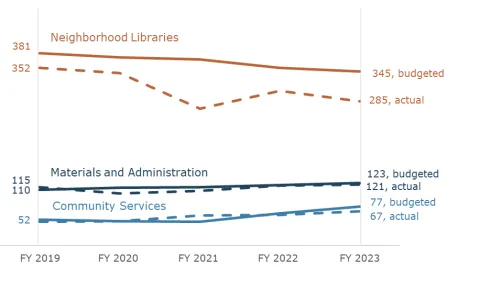
Notes: Budgeted amounts are from the adopted budget at the beginning of the fiscal year. Actual amounts are from the end of the fiscal year to allow for hiring time. Amounts are based on cost center and do not include temporary, on-call, or contracted employees, such as contracted security. When the Library reorganized, a small number of positions may have changed categories without their responsibilities or location actually changing.
- Materials and Administration includes employees working in areas like leadership and upper management, HR, and IT, as well as developing collections of books and other materials, and moving those materials around. It also includes a systemwide staffing team that filled in where needed.
- Neighborhood Libraries includes positions at Central Library, temporary libraries during construction, and all other public library locations, including security liaisons employed by the Library.
- Community Services includes teams for programming, community outreach and engagement, and answering virtual questions.
However, this trend is not just due to the pandemic and layoff situation. As the graph above shows, Library leaders have decreased the number of employees they budgeted to work across all neighborhood libraries. This was especially dramatic at Central Library, where the budgeted number of employees was around 20% lower in FY 2023 than it was in FY 2019. Some of this change may be due to a staff reorganization.
Staffing levels in other areas of the Library have been relatively flat or have increased. Budgeted staff for the community services team increased 50% between FY 2019 and FY 2023. The community services team provides services in the community and virtually. For example, staff go to schools, answer questions over the phone, or work with community groups to plan programs. However, some positions have not been filled. The number of employees budgeted to work in administration and management has risen slightly, though again not all positions are filled. The number of employees working on developing the Library’s collection of books and materials has stayed fairly flat.
Additional employees assigned to the community services team may help make up for some of the loss of employees in neighborhood libraries. Employees in community services teams will take on some work for answering virtual reference questions and planning and coordinating programs, events, and community engagement, which may have been done previously by some employees assigned to neighborhood libraries.
However, the growth in employees in community services does not fully offset the losses in neighborhood libraries, especially when looking the number of actual employees. In terms of actual staffing, around the equivalent of 45 fewer employees were working in both neighborhood libraries and community services in June 2023, compared with June 2019. Some libraries were closed for construction in June 2023.
Before construction closures, the difference was still there, but smaller. In December 2022, the neighborhood libraries and community services teams together had the equivalent of around 25 fewer actual employees than they did in June 2019. All neighborhood libraries were open in early December.
Most of the net loss in staffing within neighborhood libraries was in the clerk position, which is being phased out as part of the reorganization. Employees in the clerk position assist library patrons and sort and shelve books, among other duties. Instead, new employees are hired as either library assistants or access services assistants, which share some overlapping duties with clerks.
Library leaders reported that they did not hire staff during the pandemic due to reduced services. As bond construction approached, they again held off on hiring staff for some open positions in anticipation of construction closures.
The Library saved money by paying fewer employees in recent years. These one-time savings were put into reserves for future use. Library leaders report that a top priority for reserves is to backfill any future gaps in funding for library core services. Over $18M has also been designated for future building improvements.
Employees report higher workloads, but fewer patrons are coming into neighborhood libraries
During our audit, employees reported having heavier workloads and feeling stressed by lower staffing levels. However, the way that staffing levels have affected workload and service is complicated by changes due to the pandemic.

When we talked to employees, they frequently brought up concerns with staffing levels. They reported that lower staffing levels affect their workload and stress level, as well as the services they can provide. They also reported feeling less safe due to the low staffing. For example, employees working at Central Library told us that they work alone at desks that used to have two employees. Desks can be isolated in areas of the library without other employees nearby, which feels unsafe if a patron acts threatening or an incident occurs.
At the same time, the nature of services has changed since the pandemic. In 2022, the number of patrons entering neighborhood libraries was about half of what it was before the pandemic, according to Library data. More patrons are also accessing materials digitally than before the pandemic.
This means that even with fewer employees, there are far fewer patrons per employee than in the past. However, the number of patrons per employee is an imperfect measure of workload. Some patrons require much more time and assistance than others. Responding to security incidents also adds work.
Neighborhood libraries have closed at times due to low staffing
In 2022, the Library had to close neighborhood libraries at times due to insufficient staffing. When neighborhood libraries could not find enough staff to safely keep a neighborhood library open, they would close or go to door service. According to Library tracking, there were 44 days when this happened in the first six months of 2022.
This time period coincides with a surge in COVID-19 cases. COVID related absences contributed to the closures. However, closures have continued since then at a lower rate.
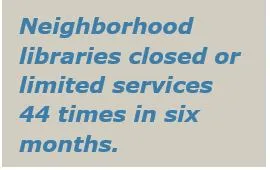
A change in internal guidelines may also have contributed to the closures. In early 2022, Library leaders increased the minimum number of employees needed to keep neighborhood libraries open for safety reasons. They made this change following pressure from the union that represents Library employees. Depending on the size of the neighborhood library, the new standards require between zero and four additional employees at a time. The policy also increased the required number of employees who are trained to be the person-in-charge. With staffing shortages, it could be difficult to meet this threshold at all times.
Furthermore, the Library has lost some flexibility to have employees fill in as needed. The pool of on-call employees decreased by half during the pandemic and has not rebounded. The Library had also discontinued a team of employees whose job it was to fill in for openings at different neighborhood libraries. Instead, the Library increased the budget to pay part-time or on-call employees to pick up additional shifts. However, that budget increase did not come with additional employees.
During construction, staffing levels are less of a concern since many employees have been reassigned. However, some neighborhood libraries have still had to close because they did not have enough employees trained and available to work as the person-in-charge. Furthermore, we heard that some neighborhood libraries are busier as they get patrons who would usually go to locations that are closed for construction.
Programming and community engagement have not ramped back up since the pandemic
The number of programs and events that the Library provided since the pandemic has been dramatically lower compared to before the pandemic started. As of December 2022, the Library was slow to reinstate programming. Programming includes things like weekly story times, computer training, or cultural events. Library leaders reports that they are in the process of reorganizing this type of work and applying equity tools to programming, which has contributed to the delay. Staffing levels, disruptions from the pandemic, and a focus on prioritizing bond work, likely also contributed.
Programming decreased dramatically during the pandemic closures and has not yet rebounded
Number of programs or events across calendar years
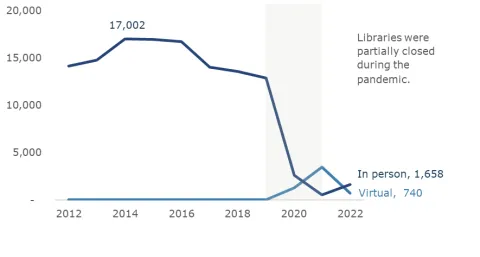
Source: Library Google tracking sheets for reported programs. Programs include those hosted by the Library and events that Library employees participated in, but do not include home visits. As this data is reported by multiple Library employees, it may not be fully complete and should be considered as estimates. Data is as of Dec. 2022 and programs may have increased since then.
Lack of staffing probably contributed to reduced services. Library leaders prioritize keeping neighborhood libraries open over having employees provide or attending events or programs.
Employees reported frustration with this. For example, multiple employees told us about a Juneteenth Celebration that was cancelled at the last minute due to insufficient staffing. There were not enough employees to both work in neighborhood libraries and at the event. Employees reported that this caused harm and distrust with the Black and African American community.
A new community engagement team could help direct the strategy for programming, outreach, and engagement. The employees on this team will have a variety of cultural and language specializations to engage with different communities. The team intends to strategically shift to engaging with the community to determine what services the community needs most. However, at the time this report was written, the team was still being built up.
Workforce equity concerns include unclear expectations and employees feeling undervalued and overworked
Library communications state that the Library values diversity, equity and inclusion principles. Library leaders have put this into action by hiring a more diverse workforce in recent years. This includes employees with cultural and language skills to provide community-specific services.
However, some employees with cultural and language skills, along with other employees, expressed frustrations of feeling undervalued and that they could not fully apply their skills. Also, Library leaders could provide clearer expectations to employees who may do community engagement or outreach on how much of this work they can or should do. Some employees with cultural and language skills may also have high workloads.
We Speak Your Language and Cultural Advocates programs have grown

Over the last 20 years, the Library has increasingly built capacity to better serve communities of color and culture. It has done this by hiring employees with specific language and cultural skills. According to a report from the American Library Association, US libraries were historically built on a foundation of exclusion and whiteness. Intentionally hiring for language and cultural skills aims to push against that history and improve inclusion and access to information and resources for people of all cultural backgrounds.
The first Library positions with language requirements were started around 20 years ago by Rita Jimenez, with a grant program to expand services for the Spanish-speaking community. Since then, the program for bilingual and usually bicultural employees, called We Speak Your Language, has grown dramatically. The Library also added Black Cultural Library Advocates and an Indigenous Team that require cultural skills, but not language skills.
At the time this report was written, we identified 132 Library employees using cultural and language skills in their positions, based on them receiving the 4% pay premium for using those skills. We were able to identify 129 of those employees as working in positions requiring specific cultural and language skills. The discrepancy may be due to data inaccuracies. It is also possible that some employees could receive bilingual pay if they regularly used language skills, even if they are not in a position designated as requiring those skills.
Over 100 employees use cultural or language skills in their positions to serve specific communities
Communities served by number of filled positions, approximately
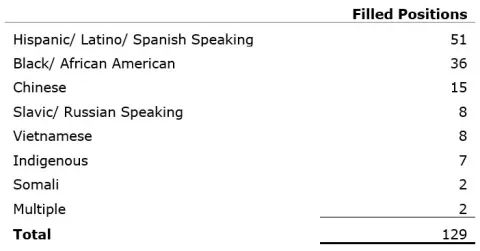
While the growth of these programs and increased employee diversity more broadly is positive, it has not been without challenges. In interviews, employees told us consistently that they valued these programs and the people working in them. But also told us that employees with language and cultural skills and Black, Indigenous, and other People of Color (BIPOC) employees broadly would benefit from more support.
Diversity, equity, and inclusion are stated Library priorities
Library leaders value hiring diverse employees who can connect with different communities in order to better provide equitable services. The Library website states that the Library “invests in specialized, culturally and linguistically relevant expertise and support to build active, trusting relationships...” At public presentations, Library leaders point to increased hiring of Black, Indigenous, and other people of color (BIPOC) employees as an achievement. Both the Multnomah County’s Workforce Equity Plan and the American Libraries Association advise reducing barriers to hiring, promoting, and retaining racially and culturally diverse employees.
Hiring employees with specific cultural and language skills is one of the Library’s strategies for improving equity and inclusion in service delivery. Hiring employees with cultural and language skills can also increase workforce diversity. However, it is important to note that not all employees with specific cultural and language skills identify as BIPOC and not all BIPOC employees are paid to use cultural and language skills in their positions.
The Library has increased hiring of BIPOC employees in recent years. For example, of the employees hired in the last two years, 18% identify as Black or African American, 4% identify as American Indian or Alaskan Native, and 13% identify as Latino or Hispanic. Compare that with employees who have worked at the Library for over two years, of whom only 7% identify as Black or African American, 1% identify as American Indian or Alaskan Native, and 11% identify as Latino or Hispanic. The percent of employees identifying as African, Middle Eastern, Slavic, and two or more races also increased. One exception is employees who identify as Asian, who made up a smaller percent of recent hires (8%) than previous hires (9%).
More Black, Indigenous, and Latino/Hispanic employees have been hired to work in the Library in the past two years, than in years before

Source: Workday. Notes: Categories are based on categories in Workday data. Graphs show the distribution by race/ethnicity among previous hires - employees hired over 2 years ago, and recent hires - employees hired within the last two years. Gray band includes the following racial/ethnic categories: African, Asian, Middle Eastern, Slavic, two or more, White, and missing or declined to answer.
While diversity, equity, and inclusion are priorities of the Library, we also heard some concerns about equity from Library employees. Some employees told us that they believed there was not follow through on the Library’s priorities and equity was more talk than action. They noted instances when they perceived that staff were not valued or communities were not being well-served. For example, some staff questioned the decision to simultaneously close multiple neighborhood libraries that serve the Black community during construction work.
Library retention rates have been fairly stable, but suggest potential differences in experiences for employees based on race and ethnicity. Overall retention rates dipped slightly when layoffs were announced during the pandemic, but have mostly rebounded. Retention rates for Black or African American employees had a large drop during the pandemic. Retention rates for employees who identify as having two or more races are also below average. Retention rates show the percent of employees who stayed working at the Library for each fiscal year.
Overall retention rates are fairly stable, but dropped during the pandemic, especially for Black employees
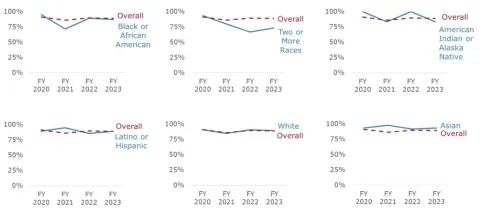
Source: Auditor analysis of Workday data. Notes: Retention rate is calculated by taking the number of employees at the start of the fiscal year that were still employed at the end of the fiscal year, divided by the total number of employees at the start of the year. These calculations do not include temporary, on-call, or contracted employees. Employees who left the Library to work in other parts of the county or who switched to on-call work were considered no longer employed at the Library.
Employees report that their expertise is not always used or valued
Employees with cultural and language skills want their expertise to be valued and applied at work. Some employees we talked to felt that they were hired for their cultural and language skills but were not treated as experts or able to apply those skills in the community. This feeling extended more broadly to include employees without cultural and language skills. We heard from employees who felt like staff and middle managers in general were not often consulted on decisions or trusted to make decisions at their level. We also heard frustrations about a lack of opportunities for advancement, or perceptions that only some employees get opportunities to advance.
Additionally, library assistants are more likely than librarians to have cultural and language skills. Half of library assistants use cultural and language skills in their jobs, compared with 25% of librarians. Library assistants answer patrons’ questions and assist librarians with managing book collections and developing community programs.
The library assistant position has a lower pay scale and requires less technical education than the librarian position, which requires a master’s degree in library science. Library assistants are also more likely to be part-time positions than librarians. We heard that hiring librarians with cultural and language skills is a challenge, since the candidate pool is smaller due to the education requirement.
Library leaders could provide clearer expectations to employees with cultural and language skills
Library employees with cultural and language skills, and other employees who may do outreach, have unclear expectations about balancing outreach and program work with other duties in neighborhood libraries.
Library leaders states that they are changing the model for community engagement, outreach, and programs. Under the new model, there is a systemwide team to do planning and coordination work for community engagement.
Employees working in neighborhood libraries can still support these systemwide efforts, but their main responsibility is to perform their position’s standard duties at their neighborhood library. Library leaders said that it is important to have employees with cultural and language skills that reflect the local community working in neighborhood libraries.

However, leaders have not made their expectations about outreach clear. The guidance about outreach on the Library’s intranet is sparse. Position descriptions can describe the intended percent of work for outreach, among other activities, based on role. However, as described above, staffing constraints can affect employees’ ability to do outreach and discretion is left to neighborhood library managers for approving outreach, which may not be consistent. Even with position descriptions, role expectations may not be clear, as they are not described in the guidance on the intranet.
Employees with cultural and language skills reported less role clarity in a survey we sent to all Library staff. In our staff survey, 54% of employees with cultural and language skills believe their roles and responsibilities are clear to them, compared to 67% of employees without cultural and language skills.
The tension between fulfilling standard duties in a neighborhood library and working on community engagement and outreach has led to some frustration.
On one hand, we heard that some employees were frustrated that they could not spend more time working on outreach or programs with community members. For some employees it contributed to feelings of being undervalued.
On the other hand, we also heard that for those employees who were able to do more community focused work, that the workload of having multiple demands was high. Some employees spent a lot of time both meeting their standard work expectations, like shelving books or answering patrons’ questions, and planning and doing outreach activities or providing input into Library initiatives.
Demands may be higher for some employees in library assistant positions. According to a survey we conducted among Library employees, library assistants using cultural or language skills reported higher workloads than library assistants in positions that did not require these skills. They also reported spending more time on community outreach.
Additionally, more responsibility may fall to the library assistants, if they do not have a librarian to assist. At the time this report was written, there were no librarian positions with Indigenous, Slavic/Russian, or Somali cultural and language skills requirements, while there are library assistant positions that require those skills.
Library leaders have an opportunity to address employee concerns when planning for fully reopening after construction
In the spring of 2023, Library leaders announced an initiative that includes planning for organizational staffing once construction work is complete and neighborhood libraries fully reopen. As planning moves forward, leaders should consider the issues identified in this report.
Planning will help ensure that the Library can provide its core services to the public. The Library initially estimated that construction for new and renovated neighborhood libraries will be completed by fall 2025. That leaves less than two years to plan, budget, hire, and train any additional staff that will be needed.
Library leaders have an opportunity with the current construction closures to proactively plan for future Library operations and address employees’ concerns.
Planning for the future should address issues in this report and ensure that core services will be delivered
Library leaders have announced an initiative to plan for future staffing. They state they will form a team to look at staffing in new spaces. They state that this initiative will also link with other planning work they are already doing.
As Library leaders move forward with future planning, they should address the issues raised in this report. These issues include having sufficient staff to provide services and meet security concerns. Leaders should also clarify the work expectations for employees with cultural and language skills and plan for balanced workloads.
We also heard suggestions that the distribution of staff with languages and culture skills could be reviewed or expanded. For example, an employee suggested having a designation and pay premium for LGBTQ+ cultural skills at the Library. Another employee said that the number of employees with Vietnamese and Russian language skills have not increased in many years. According to the Library’s strategic plan, leaders are planning to do a review of language and cultural services.
Trauma-informed internal communication could help rebuild trust
Throughout our audit, we consistently heard a desire from employees for better communication and more transparent decision-making. Library leaders already communicate extensively internally, however there is still a disconnect with employees.
Trust between Library leaders and employees was damaged when leaders announced layoffs in 2020. For some employees, nothing short of all new leadership could repair that broken trust. Other employees would like to move on as an organization. However, when communication or decision-making falls short of expectations, it can become further evidence to employees of the disconnect between leaders and staff.
To rebuild trust, support employees in a trauma-informed manner, and facilitate organizational change, Library leaders should strive to continually improve transparency and clarity in communications and decision-making. Multnomah County strives to be a trauma-informed work place. Many Library employees feel they have experienced trauma in their workplace due to security issues, the pandemic, and the threat of layoffs. Transparent communication and involving people in decisions are important principles of trauma-informed practices. Additionally, internal communication is a critical component of change management. As the Library undergoes organizational change, communication is even more important.
Library leaders do already communicate extensively internally. Updates on various changes are posted on the intranet and communicated through emails. The Library also hosts webinars about once a month for presenters to share about different projects and events in the Library. And leaders have held listening sessions to gather staff feedback on major initiatives.
Yet there is still a large disconnect between Library employees and Library leaders. Employees feel like when they can give input they are not listened to. They often told us that they would like to see more, clearer, and earlier communication. Employees said they were often surprised by decisions and did not understand the rationale for them. For example, some employees were surprised when Library leaders announced that some neighborhood libraries would no longer have county employees providing security but would switch to contracted security. Leaders did not explain why they decided to switch and some employees said they did not understand or agree with the decision.
During the course of our audit, we saw examples of thorough communication and communication that was incomplete. For example, after an assault on an employee at the Kenton Library, managers sent out multiple emails to all employees. However, when a patron hid in the Central Library building after hours with a large knife, leaders did not send an email to all staff. They only sent an email to Central Library employees. The lack of communication with all employees creates an environment where rumors could spread and staff can feel that leaders were withholding important information from them.
According to the Society of Human Resource Managers and the Government Communications Service (UK), good communication is critical for change management. These sources state that internal communications should be through multiple methods and from multiple sources. Leaders should allow employees to explore the implications of changes. Leaders should listen to employees to identify misunderstandings and respond to concerns. They should allow time for messages to sink in, be honest about the reasons behind changes, involve middle managers, and allow opportunities for face to face discussions.
While Library leaders already employs some of these strategies, they could be more consistent. They could also communicate more clearly by using more direct and plain language. Refining how to clearly and authentically communicate about the important changes that affect employees the most would benefit the whole Library system.
Recommendations
We recommend that Library leaders:
By January 1, 2024
1. Implement corrective actions and processes to ensure safety committees are meeting OSHA standards and champion them as a place to address security issues.
2. Coordinate with the County Security Program to complete a Workplace Violence Threat Assessment and Workplace Violence Prevention Plan and communicate the results to all employees.
By June 1, 2024
3. Create a plan for continuous evaluation of the safety and security program, including:
a. Evaluating security-related trainings, informed by staff feedback.
b. Developing a process to ensure all public facing staff have taken trainings and get refreshers.
c. Implementing an incident reporting process that includes data analysis of trends and identifying and documenting corrective actions.
4. Revise post-incident protocols to provide more detail, particularly around supporting staff and debriefing, providing guidance on serious but not “critical” incidents, as well as allowing more decision-making at the neighborhood library level.
5. Communicate to all staff after serious incidents and communicate summaries of incidents and trends.
6. Communicate the vision for outreach and engagement to all staff, including expectations on community outreach for staff working in neighborhood libraries.
7. Identify and document upcoming changes that will affect employees, which could benefit from focused internal communications.
a. For each change identified, implement a communications strategy that identifies multiple methods of communication, involves an element of staff input, and explains the reasons behind changes.
8. Develop and communicate a plan for the leadership team to regularly spend time onsite in neighborhood libraries.
By October 1, 2024:
9. Develop a staffing plan for when all construction is complete. In line with the findings in this audit, the staffing plan should solicit employee input during development and address:
a. Security, examining staffing for security and social work personnel including coverage on evenings and weekends.
b. Adapting the person-in-charge model to meet union agreements.
c. Staffing for neighborhood libraries, so they stay open.
d. Community engagement, so programs, outreach, events and engagement can increase, while addressing employee concerns around workload and opportunities.
e. Cultural and language skill allocation by position and location.
f. Allowing time to hire for hard to fill positions.
10. Communicate the staffing plan to Library employees and present to Board of County Commissioners both before all buildings fully reopen and after reopening. Request budget changes as needed to support the staffing plan.
g. Initial communication to staff and Board should occur by October 1, 2024. Follow up communication should occur by October 1, 2026.
Objectives, Scope, & Methodology
- The objectives of this audit were to:
Describe the current security model, assess impacts on the safety environment, and identify improvements in safety and security. - Identify structural staffing challenges that contribute to equity issues in the Library work environment.
- To accomplish these objectives, we:
Conducted 74 interviews, mostly with Library staff (37) and managers (25), many randomly selected to avoid bias, also sought out people based on expertise - Performed five library site visits.
- Distributed and analyzed a library staff survey with 76% response rate
- Reviewed and analyzed documents, including incident reports and RSk-2 forms
- Researched OSHA guidance and other best practices
- Reviewed library policies, guidance, and documentation
- Analyzed Workday and Questica data to look at FTE and retention rates over time
The audit scope focused on FY 2022 and FY 2023.
For this audit, we analyzed HR data for the time period of FY19 – FY23 from Workday, the county’s enterprise resource planning system and Questica, the county’s budgeting system. We also analyzed data related to incident reports and programs at the Library. Incident report data is initially entered in Google forms, then moved to the Library’s data system called Security Incident Reporting Database (SIR). Programming data is entered and retained in Google sheets, then uploaded to a data mart.
We assessed the reliability of data by (1) performing electronic testing for obvious errors in accuracy and completeness, (2) interviewing county officials knowledgeable about the data, (3) reviewing related documentation, and (4) worked closely with county officials to identify any data problems. We determined that the data were sufficiently reliable for the purposes of this report.
We conducted this performance audit in accordance with generally accepted government auditing standards. Those standards require that we plan and perform the audit to obtain sufficient, appropriate evidence to provide a reasonable basis for our findings, and conclusions based on our audit objective. We believe that the evidence obtained provides a reasonable basis for our findings and conclusions based on our audit objectives.
Appendix A. Employee Survey Results
Staff
Nicole Dewees, Audit Director
Caroline Zavitkovski, Audit Director
Mical Yohannes, Management Auditor
Dorian Pacheco, Management Auditor
